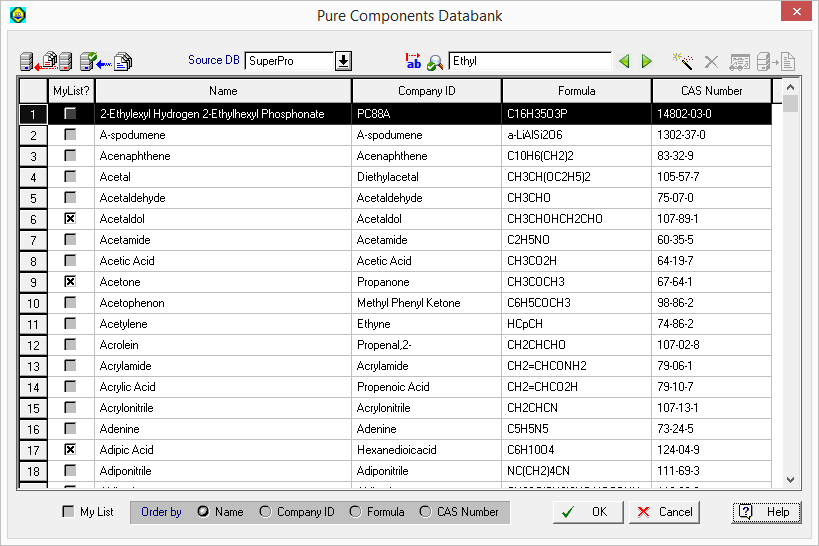

This dialog appears by selecting Databanks } Pure Components from the main menu of the application.
From this dialog you can:
1. View the contents of the pure component databanks (‘Designer’, ‘User’, ‘DIPPR’ or ‘PPDS’).
2. Add, delete or modify the properties of pure components in the ‘User’ databank.
|
|
Using the ‘Database Filter...’ |
► To view/edit the contents of a pure component databank…
1. Choose a pure component from the table by selecting a row. Depending on whether you have selected a component in the table that belongs to the ‘User’, or the ‘Designer’/’DIPPR’/‘PPDS’ databases you can either view and edit or only view the properties of that component respectively. The button icon for viewing/editing the properties of the selected component changes accordingly from the View Properties (  ) button to the Edit Properties (
) button to the Edit Properties ( ) button and vice-versa.
) button and vice-versa.
2. If you have chosen a ‘Designer’, ‘DIPPR’ or ‘PPDS’ component, then proceed to view its properties by clicking on the View Properties ( ) button. The Pure Component Properties Dialog will be displayed. This dialog presents in several tabs the property values for the selected components. Notice that you cannot modify and save any values on this dialog. If you have chosen a ‘User’ component, then instead of the View Properties (
) button. The Pure Component Properties Dialog will be displayed. This dialog presents in several tabs the property values for the selected components. Notice that you cannot modify and save any values on this dialog. If you have chosen a ‘User’ component, then instead of the View Properties ( ) button, the Edit Properties (
) button, the Edit Properties ( ) button will appear. After selecting a component, and pressing this button, the Pure Component Properties Dialog will appear once again, only this time, you can view as well as edit and save new property values for the selected component.
) button will appear. After selecting a component, and pressing this button, the Pure Component Properties Dialog will appear once again, only this time, you can view as well as edit and save new property values for the selected component.
► To add a new component in the ‘User’ databank…
3. Click on the Add New Component ( ) button to present the New Component Definition Dialog. Fill in the fields for the new component’s name, CAS number, trade name, local name, formula and company ID. The name and local name fields must contain strings that are unique across the whole databank. The system will not allow you to introduce a chemical that has any index conflict with existing chemicals in the databank, also the name and formal name of the component must be unique in the ‘User’ database. Exit with OK.
) button to present the New Component Definition Dialog. Fill in the fields for the new component’s name, CAS number, trade name, local name, formula and company ID. The name and local name fields must contain strings that are unique across the whole databank. The system will not allow you to introduce a chemical that has any index conflict with existing chemicals in the databank, also the name and formal name of the component must be unique in the ‘User’ database. Exit with OK.
4. A new entry in the component databank will be created. Note that the new component is created with property values that are copied from another pre-existing component (either in the ‘Designer’ or the ‘User’ databank, as chosen in the New Component Definition Dialog). Before you save the new component as part of the ‘User’ databank, you may edit its properties by clicking on the Edit Properties ( ) button.
) button.
|
|
Make sure you have typed the name of the component correctly. Once the component is included in the databank, this field cannot be edited again; the only way to modify it would be to completely remove it from the databank and introduce it again with the new name. |
It is reminded to the user that new components can be introduced either in the ‘User’ databank and then later registered in a process simulation file, or they can be directly introduced (registered) in a process simulation file (without ever having a record in the ‘User’ databank). If the component is introduced in the ‘User’ databank first, then it will stay there and it can be retrieved for registration from any future process simulation projects. If the component is introduced directly in a process simulation file, it can also be later exported (deposited) to the ‘User’ databank (if needed); for more details, see Pure Component Registration Dialog.
► To delete a pure component from the ‘User’ databank…
5. Select the component that you want to delete (click anywhere on that component’s row). If the component resides in the ‘User’ database the Delete ( ) button is enabled.
) button is enabled.
6. Click on the Delete ( ) button.
) button.
► To save the ‘User’ databank…
1. To save the changes made in the databank back into the ‘User’ database, you may either click on OK (this will exit the dialog) or you can click on the Save Database to Disk ( ) button (this will save the data but keep the dialog session open).
) button (this will save the data but keep the dialog session open).
|
|
Once the changes in the databank are saved into the ‘User’ database, they are irreversible. In case you change your mind about changes made, and these are not yet saved, you may cancel changes and revert to the saved databank by clicking Cancel on the dialog. |
See Also: